ASUS RT-G32 User Manual [ru]
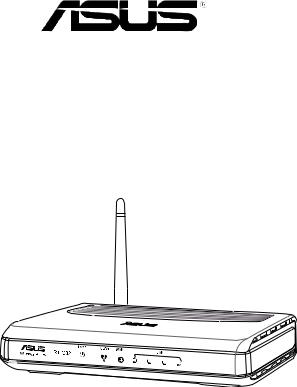
RT-G32
Wireless Router
User Manual

E4264
First Edition
November 2008
Copyright © 2008 ASUSTeK Computer Inc. All Rights Reserved.
No part of this manual, including the products and software described in it, may be reproduced, transmitted, transcribed, stored in a retrieval system, or translated into any language in any form or by any means, except documentation kept by the purchaser for backup purposes, without the express written permission of ASUSTeK Computer Inc. (“ASUS”).
Product warranty or service will not be extended if: (1) the product is repaired, modified or altered, unless such repair, modification of alteration is authorized in writing byASUS; or (2) the serial number of the product is defaced or missing.
ASUS PROVIDES THIS MANUAL “AS IS” WITHOUT WARRANTY OF ANY KIND, EITHER EXPRESS OR IMPLIED, INCLUDING BUT NOT LIMITED TO THE IMPLIED WARRANTIES OR CONDITIONS OF MERCHANTABILITY OR FITNESS FOR A PARTICULAR PURPOSE. IN NO EVENT SHALL ASUS, ITS DIRECTORS, OFFICERS, EMPLOYEES OR AGENTS BE LIABLE FOR ANY INDIRECT, SPECIAL, INCIDENTAL, OR CONSEQUENTIAL DAMAGES (INCLUDING DAMAGES FOR LOSS OF PROFITS, LOSS OF BUSINESS, LOSS OF USE OR DATA, INTERRUPTION OF BUSINESS AND THE LIKE), EVEN IF ASUS HAS BEEN ADVISED OF THE POSSIBILITY OF SUCH DAMAGES ARISING FROM ANY DEFECT OR ERROR IN THIS MANUAL OR PRODUCT.
SPECIFICATIONS AND INFORMATION CONTAINED IN THIS MANUAL ARE FURNISHED FOR INFORMATIONAL USE ONLY, AND ARE SUBJECT TO CHANGE AT ANY TIME WITHOUT NOTICE, AND SHOULD NOT BE CONSTRUED AS A COMMITMENT BY ASUS. ASUS ASSUMES NO RESPONSIBILITY OR LIABILITY FOR ANY ERRORS OR INACCURACIES THAT MAY APPEAR IN THIS MANUAL, INCLUDING THE PRODUCTS AND SOFTWARE DESCRIBED IN IT.
Products and corporate names appearing in this manual may or may not be registered trademarks or copyrights of their respective companies, and are used only for identification or explanation and to the owners’ benefit, without intent to infringe.

Table of contents |
|
About this guide..................................................................................... |
4 |
How this guide is organized............................................................... |
4 |
Conventions used in this guide.......................................................... |
5 |
Knowing your wireless router |
6 |
Package contents................................................................................... |
6 |
System requirements............................................................................. |
6 |
Before you proceed................................................................................ |
6 |
Hardware features.................................................................................. |
7 |
Front panel......................................................................................... |
7 |
Rear panel......................................................................................... |
8 |
Back panel......................................................................................... |
9 |
Mounting options................................................................................. |
10 |
Setting up the hardware |
11 |
Setting up the wireless router.............................................................. |
11 |
Setting up a wired connection........................................................... |
11 |
Setting up a wireless connection..................................................... |
12 |
Configuring the wireless router.......................................................... |
12 |
Using the web GUI........................................................................... |
12 |
Configuring the network clients |
14 |
Accessing the wireless router............................................................ |
14 |
Setting an IP address for wired or wireless client............................ |
14 |
Configuring via the web GUI |
21 |
Configuring via the web GUI............................................................... |
21 |
Configuring the Settings..................................................................... |
22 |
Upgrading the firmware................................................................... |
22 |
Restoring/Saving/Uploading settings............................................... |
23 |
Installing the utilities |
24 |

Table of contents
Installing the utilities............................................................................ |
24 |
Firmware Restoration.......................................................................... |
26 |
Device Discovery.................................................................................. |
26 |
EZSetup................................................................................................. |
29 |
WPS Quick Button Setup................................................................. |
32 |
Troubleshooting |
33 |
|
Troubleshooting................................................................................... |
33 |
|
Appendices |
36 |
36 |
Notices.................................................................................................. |
|
|
GNU General Public License............................................................... |
38 |
|
ASUS Contact information.................................................................. |
44 |
|
About this guide
This user guide contains information that you need to install and configure the
ASUS Wireless Router.
How this guide is organized
This guide contains the following parts:
•Chapter 1: Knowing your wireless router
This chapter provides information on the package contents, system requirements, hardware features, and LED indicators of the ASUS Wireless Router.
•Chapter 2: Setting up the hardware
This chapter provides instructions on setting up, accessing, and configuring the
ASUS Wireless Router.
•Chapter 3: Configuring the network clients
This chapter provides instructions on setting up the clients in your network to work with your ASUS Wireless Router.

•Chapter 4: Configuring via the web GUI
This chapter provides instructions on configuring theASUS Wireless Router using its web graphics user interface (web GUI).
•Chapter 5: Installing the utilities
This chapter provides information on the utilities that are available from the support CD.
•Chapter 6: Troubleshooting
This chapter provides you with a troubleshooting guide for solving common problems you may encounter when using the ASUS Wireless Router.
•Appendices
This chapter provides you with the regulatory Notices and Safety Statements.
Conventions used in this guide
WARNING: Information to prevent injury to yourself when trying to complete a task.
CAUTION: Information to prevent damage to the components when trying to complete a task.
IMPORTANT: Instructions that you MUST follow to complete a task.
NOTE: Tips and additional information to aid in completing a task.

Knowing 1your wireless router
Package contents
Check the following items in your ASUS Wireless Router package.
RT-G32 Wireless Router
Power adapter
Support CD (manual, utilities)
RJ45 cable
Quick Start Guide
Note: If any of the items is damaged or missing, contact your retailer.
System requirements
Before installing the ASUS Wireless Router, ensure that your system/network meets the following requirements:
•An Ethernet RJ-45 port (10Base-T/100Base-TX)
•At least one IEEE 802.11b/g device with wireless capability
•An installed TCP/IP and Internet browser
•This utility supports Internet Explorer 6.0 or later version.
Before you proceed
Take note of the following guidelines before installing the ASUS Wireless Router:
•The length of the Ethernet cable that connects the device to the network (hub, ADSL/cable modem, router, wall patch) must not exceed 100 meters.
•Place the device on a flat, stable surface as far from the ground as possible.
•Keep the device clear from metal obstructions and away from direct sunlight.
•Keep the device away from transformers, heavy-duty motors, fluorescent lights, microwave ovens, refrigerators, and other industrial equipment to prevent signal loss.
RT-G32 |
Chapter 1: Knowing your wireless router |
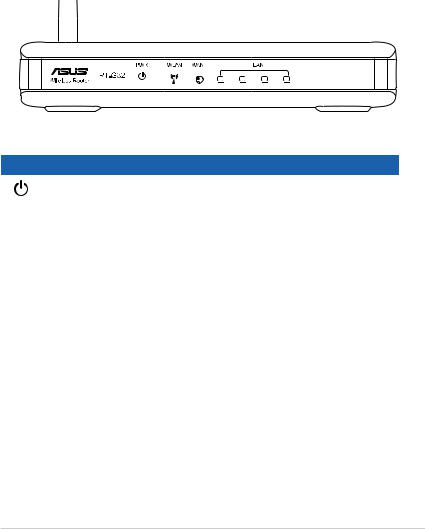
•Install the device in a central area to provide ideal coverage for all wireless mobile devices.
•Install the device at least 20cms from a person to insure that the product is operated in accordance with the RF Guidelines for Human Exposure adopted by the Federal Communications Commission.
Hardware features
Front panel
Status indicators
LED |
Status |
Indication |
|
(Power) |
Off |
No power |
|
On |
System ready |
||
|
|||
WLAN |
Off |
No power |
|
(Wireless |
|
|
|
On |
Wireless system ready |
||
LAN) |
|||
Flashing |
Transmitting or receiving data (wireless) |
||
|
|||
LAN 1-4 |
Off |
No power or no physical connection |
|
(Local Area |
|
|
|
On |
Has physical connection to an Ethernet |
||
Network) |
|||
|
network |
||
|
Flashing |
Transmitting or receiving data (through |
|
|
|
Ethernet cable) |
|
WAN |
Off |
No power or no physical connection |
|
(Wide Area |
|
|
|
On |
Has physical connection to an Ethernet |
||
Network) |
|||
|
network |
||
|
Flashing |
Transmitting or receiving data (through |
|
|
|
Ethernet cable) |
Chapter 1: Knowing your wireless router |
RT-G32 |

Rear panel
Label |
Description |
ANTENNA |
Adjust the antenna manually to get a better signal reception |
WPS |
Press this button to launch the Wi-Fi Protected Setup (WPS). |
Reset |
Press for three seconds to restore to the factory default |
|
settings. |
WAN |
Connect an RJ-45 Ethernet cable to this port to establish |
|
WAN connection. |
LAN1-LAN4 |
Connect RJ-45 Ethernet cables to these ports to establish |
|
LAN connection. |
DC 12V |
Insert the DC adapter into this port to connect your router to |
|
a power source. |
RT-G32 |
Chapter 1: Knowing your wireless router |

Back panel
2
1
Item |
Description |
1Mounting hooks
Use the mounting hooks to mount your router on concrete or wooden surfaces using two roundhead screws.
2Air vents
These vents provide ventilation to your router.
Note: For details on mounting your router on a wall or ceiling, refer to the section Mounting options on the next page of this user manual.
Chapter 1: Knowing your wireless router |
RT-G32 |
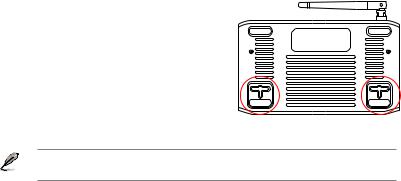
Mounting options
Out of the box, theASUS Wireless Router is designed to sit on a raised flat surface like a file cabinet or book shelf. The unit may also be converted for mounting to a wall or ceiling.
To mount the ASUS Wireless Router:
1.Look on the underside for the two mounting hooks.
2. Mark two upper holes in a flat surface.
3.Tighten two screws until only 1/4'' is showing.
4.Latch the hooks of the ASUS Wireless Router onto the screws.
Note: Re-adjust the screws if you cannot latch the ASUS Wireless Router onto the screws or if it is too loose.
10 |
RT-G32 |
Chapter 1: Knowing your wireless router |
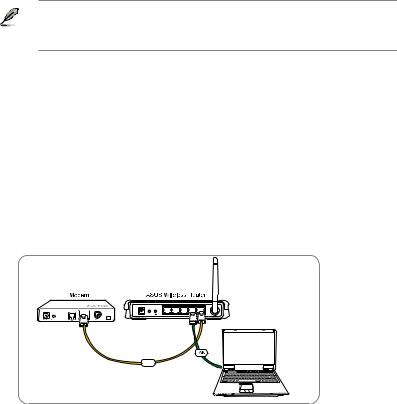
Setting up2the hardware
Setting up the wireless router
The ASUS Wireless Router meets various working scenarios with proper configurations. You may need to change the wireless router’s default settings so as to meet the requirements in your wireless environment. It also provides you with EZSetup, a utility that enables you to easily set up a secure wireless network.
Notes:
•For more details on EZSetup, refer to the section EZSetup in Chapter 5 of this user manual.
Setting up a wired connection
The ASUS Wireless Router is supplied with an Ethernet cable in the package. The wireless router has integrated auto-crossover function, so use either straight-through or crossover cable for wired connection.
To set up the wired connection:
1.Turn on your router and the modem.
2.Using an Ethernet cable, connect the router’s WAN port to the modem.
3.Using another Ethernet cable, connect the router’s LAN port to your PC’s LAN port.
WAN
|
|
|
|
|
|
|
|
|
|
|
|
Chapter 2: Setting up the hardware |
|
RT-G32 |
11 |
||

Setting up a wireless connection
To set up a wireless connection:
1.Turn on your router and the modem.
2.Using an Ethernet cable, connect the modem to the router’s WAN port.
3.Connect an IEEE 802.11b/g compatible WLAN card. Refer to your wireless adapter user manual for wireless connection procedures. By default, the SSID of ASUS Wireless Router is “default” (in lower case), encryption is disabled and open system authentication is used.
Configuring the wireless router
The ASUS Wireless Router includes a web graphics user interface (web GUI) which allows you to configure the wireless router using a web browser on your computer.
Using the web GUI
If your PC connects to the router using a cable, launch a web browser and the login page of the router’s web GUI is automatically launched.
If your PC connects to the router wirelessly, you have to select the network first.
To select the network:
1.Click Start > Control Panel > Network Connections > Wireless Network Connection.
2.Select a network from the Choose a wireless network window. Wait for it to connect.
Note: By default, the SSID of wireless router is default. Connect to this default SSID.
12 |
RT-G32 |
Chapter 2: Setting up the hardware |

3. After establishing a wireless connection, launch a web browser.
Notes:
•You may also manually key in the router's default IP address (192.168.1.1) to launch the router's web interface.
•For more details on configuring your wireless router using the web GUI, refer to Chapter 4:
Configuring via the web GUI.
Chapter 2: Setting up the hardware |
RT-G32 |
13 |

Configuring3the
network clients
Accessing the wireless router
Setting an IP address for wired or wireless client
To access the ASUS Wireless Router, you must have the correct TCP/IP settings on your wired or wireless clients. Ensure that the clients’ IP addresses are within the same subnet as the ASUS Wireless Router.
By default, the ASUS Wireless Router integrates the DHCP server functions, which automatically assign IP addresses to the clients in your network.
But in some instances, you may want to manually assign static IP addresses on some of the clients or computers in your network rather than automatically getting IP addresses from your wireless router.
Follow the instructions below that correspond to the operating system installed on your client or computer.
Note: If you want to manually assign an IP address to your client, we recommend that you use the following settings:
•IP address: 192.168.1.xxx (xxx can be any number between 2 and 254. Ensure that the IP address is not used by another device)
•Subnet Mask: 255.255.255.0 (same as the ASUS Wireless Router)
•Gateway: 192.168.1.1 (IP address of the ASUS Wireless Router)
•DNS: 192.168.1.1 (ASUS Wireless Router) or assign a known DNS server in your network
14 |
RT-G32 |
Chapter 3: Configuring the clients |
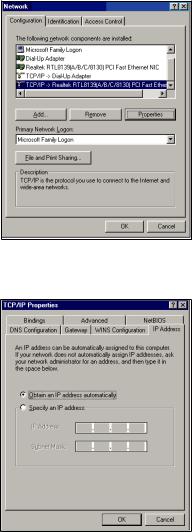
Windows® 9x/ME
1.Click Start > Control Panel >
Network to display the Network setup window.
2.Select TCP/IP then click
Properties.
3.If you want your computer to automatically obtain an IP address, click Obtain an IP address automatically then click OK. Otherwise, click Specify an
IP address, then key in the IP address and Subnet Mask.
Chapter 3: Configuring the clients |
RT-G32 |
15 |
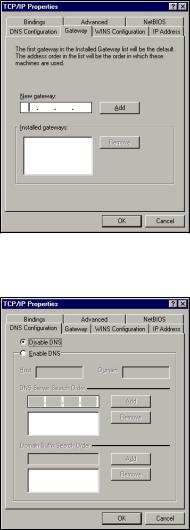
4.Select Gateway tab, and key in
New gateway then click Add.
5.Select the DNS configuration tab and click Enable DNS. Key in Host,
Domain, and DNS Server Search Order, then click Add.
6.Click OK.
16 |
RT-G32 |
Chapter 3: Configuring the clients |
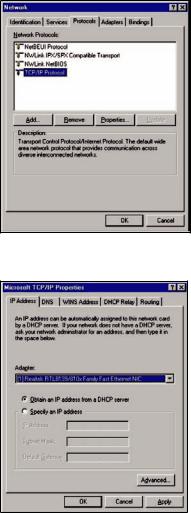
Windows® NT4.0
1.Go to Control Panel > Network to display the Network setup window then select the Protocols tab.
2.Select TCP/IP Protocol from the Network Protocols list then click
Properties.
3.From the IP Address tab of the Microsoft TCP/IP Properties windows, you can:
•Select the type of network adapter installed in your system.
•Set the router to assign IP address automatically.
•Manually set up the IP address, subnet mask, and default gateway.
Chapter 3: Configuring the clients |
RT-G32 |
17 |
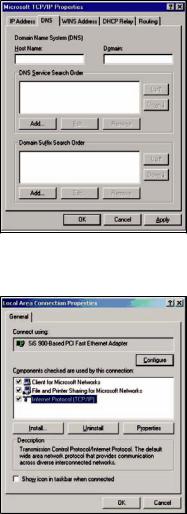
4.Select DNS tab then click Add under the DNS Service Search Order and key in DNS.
Windows® 2000
1.Click Start > Control Panel > Network and Dial-up Connection. Right-click Local Area Connection then click Properties.
18 |
RT-G32 |
Chapter 3: Configuring the clients |
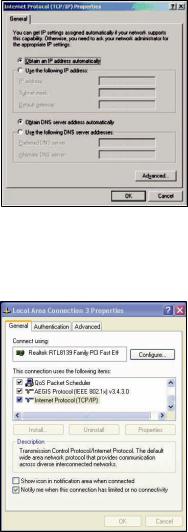
2.Select Internet Protocol (TCP/IP), then click Properties.
3.Select Obtain an IP address automatically if you want the IP settings to be assigned
automatically. Otherwise, select
Use the following IP address: and key in IP address, Subnet mask, and Default gateway.
4.Select Obtain an IP address automatically if you want the DNS server settings to be assigned automatically. Otherwise, select
Use the following DNS server address: and key in the Preferred and Alternate DNS server.
5.Click OK when done.
Windows® XP
1.Click Start > Control Panel > Network Connection. Right-click Local Area Connection then select Properties.
Chapter 3: Configuring the clients |
RT-G32 |
19 |
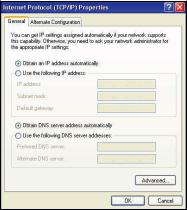
2.Select Internet Protocol (TCP/IP), then click Properties.
3.Select Obtain an IP address automatically if you want the IP settings to be assigned
automatically. Otherwise, select
Use the following IP address: and key in IP address, Subnet mask, and Default gateway.
4.Select Obtain DNS server address automatically if you want the DNS server settings to be assigned automatically. Otherwise, select Use the following DNS server addresses: and key in the
Preferred and Alternate DNS server.
5.Click OK when done.
20 |
RT-G32 |
Chapter 3: Configuring the clients |
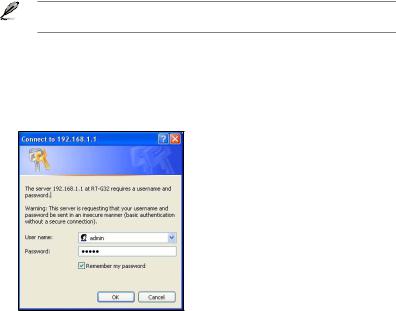
Configuring via4the web GUI
Configuring via the web GUI
The router’s web graphics user interface (web GUI) allows you to configure the feature: Setting.
To configure via the web GUI:
1.After setting up a wired or wireless connection, launch a web browser. The login page is automatically launched.
Note: You may also manually key in the router’s default IP address (192.168.1.1) to launch the router’s web interface.
2.On the login page, key in the default user name (admin) and password (admin).
3.From the main page, click the navigation menu or links to configure the various features of the ASUS Wireless Router.
Chapter 4: Configuring via the web GUI |
RT-G32 |
21 |

Configuring the Setting
Thispageallowsyoutoconfiguresettingfortherouterandyournetwork.Itenables youtoconfigurethesettingfor:Wireless, LAN, WAN, Firewall, Administration, and System Log.
To launch the Setting page:
•Click Setting from the navigation menu at the left side of your screen.
Upgrading the firmware
Note: Download the latest firmware from theASUS website at http://www.asus.com
To upgrade the firmware:
1.Click Setting from the navigation menu at the left side of your screen.
2.Under the Administration menu, click Firmware Upgrade.
3.In the New Firmware File field,clickBrowse tolocatethenewfirmwareonyour computer.
4.Click Upload. The uploading process takes about three minutes.
Note: If the upgrade process fails, the wireless router automatically enters the emergency or failure mode and the power LED indicator at the front panel flashes slowly. To recover or restore the system, use the Firmware Restoration utility. For more details on this utility, refer to the section Firmware Restoration in Chapter 5 of this user manual.
22 |
RT-G32 |
Chapter 4: Configuring via the web GUI |
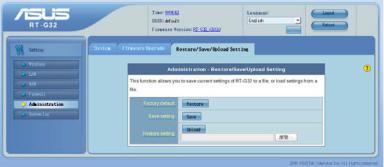
Restoring/Saving/Uploading settings
To restore/save/upload the settings:
1.Click Setting from the navigation menu at the left side of your screen.
2.Under the Administration menu, click Restore/Save/Upload Setting.
3.Select the tasks that you want to do:
•To restore to the default factory settings, click Restore, and click OK in the confirmationmessage.
•To save the current system settings, click Save, and click Save inthefile downloadwindowtosavethesystemfileinyourpreferredpath.
•To restore previous system settings, click Browse tolocatethesystemfilethat you want to restore, then click Upload.
Chapter 4: Configuring via the web GUI |
RT-G32 |
23 |
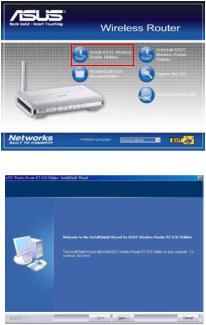
Installing5the
utilities
Installing the utilities
The support CD contains the utilities for configuring theASUS Wireless Router.
To install the ASUS WLAN Utilities in Microsoft® Windows, insert the support CD in the CD drive. If Autorun is disabled, run setup.exe from the root directory of the support CD.
To install the utilities:
1.Click Install ASUS Wireless Router Utilities.
2.Click Next.
24 |
RT-G32 |
Chapter 5: Installing the utilities |

3.Click Next to accept the default destination folder or click Browse to specify another path.
4.Click Next.
5.Click Install to install the utility.
6.Click Finish when setup is complete.
Chapter 5: Installing the utilities |
RT-G32 |
25 |
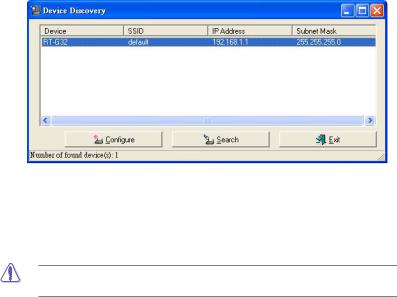
Device Discovery
Device Discovery is an ASUS WLAN utility which detects an ASUS Wireless
Router device, and enables you to configure the device.
To launch the Device Discovery utility:
•From your computer’s desktop, click Start > All Programs > ASUS Utility > RT-G32 Wireless Router > Device Discovery.
Firmware Restoration
Firmware Restoration is a utility that searches for an ASUS Wireless Router that failed during its firmware upgrading process, then restores or re-uploads the firmware that you specify. The process takes about three to four minutes.
DO NOT use this utility unless you encounter abnormal situations such as a corrupt firmware, upgrading failure, or system crash.
1.Download the latest firmware version and utility from our website at
(http://support.asus.com/download/download.aspx?SLanguage=en-us).
2.Decompress the utility file, then run Setup.exe. Click Next to finish the installation.
26 |
RT-G32 |
Chapter 5: Installing the utilities |
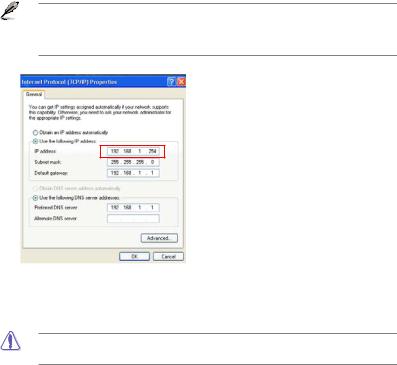
Set IP address manually
Click Start > Control Panel > Network Connection. Right-click Local Area Connection then select Properties.
Set the IP address manually (192.168.1.254).
• We suggest you use wired connection and set the IP address manually in order to gain an ideal environment for transmission.
• Make sure firewall on PC is disabled.
3.Power off the wireless router, press and hold the reset button and then power on the device again. The wireless device enters the rescue mode after the
WLAN LED flashes.
DO NOT shut down or reset the device while updating the firmware! Doing so can cause system boot failure!
Chapter 5: Installing the utilities |
RT-G32 |
27 |

4.From your Windows® desktop, click > Start > All programs > ASUS Utility >
RT-G32 Wireless Router > Firmware Restoration.
5.Click Browse to choose the firmware file and then click Upload.
6. After uploading the firmware successfully, the device automatically reboots.
28 |
RT-G32 |
Chapter 5: Installing the utilities |
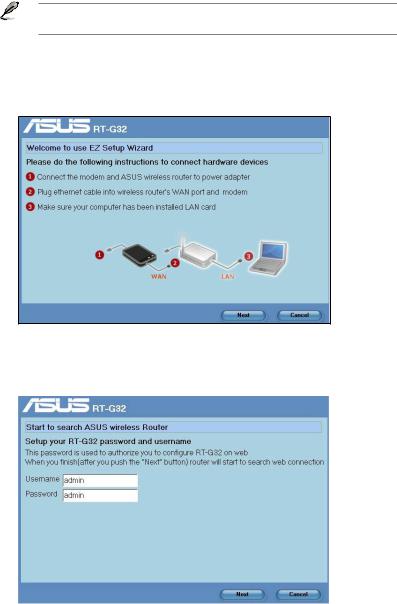
EZSetup
EZSetup is a utility that allows you to easily set up your wireless network
Before you install the EZSetup, ensure that your RT-G32 is connected the modem or PC by RJ45 cable..
To use EZSetup:
1. Follow the instructions to connect the hardware device. When done, click Next.
2.Key in the user name and password to configure the wireless router on the web. When done, click Next.
Chapter 5: Installing the utilities |
RT-G32 |
29 |
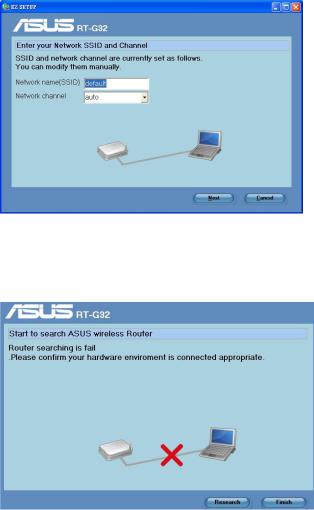
3.After setting up the network SSID and channel are connected, click Next to continue.
(Connecting)
If the connection failed, ensure that the hardware environment is connected appropriate and click Re-search to search again.
(Connection failed)
30 |
RT-G32 |
Chapter 5: Installing the utilities |
